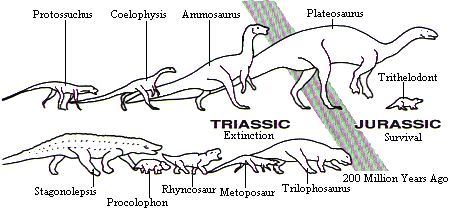
The dinosaurs of Nova Scotia are very important because they are rare examples of the animals that survived a major mass extinction event that occurred 200 million years ago.
"This is the only place where you can see accurately dated, the change in the animal assemblage through that critical time when the dinosaurs began to rule the earth."
Paul Olsen, 1984
The first dinosaurs appeared near the end of the Triassic period. During the Jurassic, which began roughly 200 million years ago, many new dinosaur types, from the huge sauropods to tiny bird-like predators, evolved. The Bay of Fundy is the only place where there are abundant bones and footprints from rocks of both ages. This has given paleontologists a rare opportunity to study the changes that occurred at a critical juncture in earth history known as the Triassic-Jurassic boundary.
The Prosauropod dinosaurs being studied at the museum are examples of animals that survived the mass extinction. Scientists at the Museum are trying to find out what permitted them to survive such a dramatically changing world.
Nearly half of the Triassic creatures failed to survive this threshold of time. Some scientists believe that the extinctions or "great dyings" that have been repeated many times throughout geological history are related to catastrophic events, perhaps asteroids hurtling into the earth. The fossil evidence at Parrsboro strongly suggests a "catastrophic extinction" heralded the dawning of the dinosaurs' reign at the Triassic-Jurassic boundary.